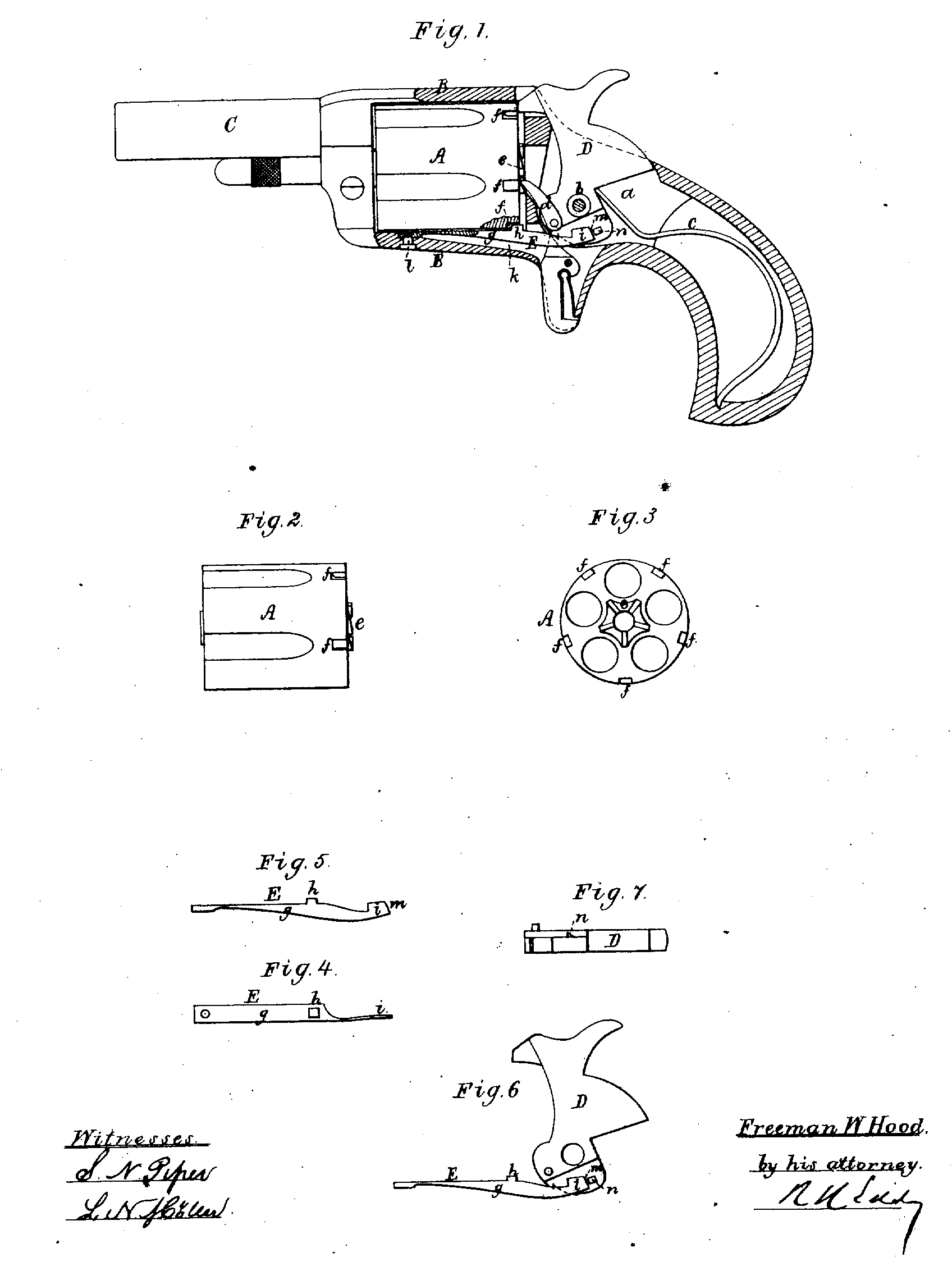US 161615
UNITED STATES PATENT OFFICE.
FREEMAN W. HOOD, OR NORWICH, CONNECTICUT, ASSIGNOR TO THE HOOD FIRE-ARMS COMPANY, OF SAME PLACE.
IMPROVEMENT IN REVOLVING FIRE-ARMS.
Specification forming part of Letters Patent No. 161,615, dated April 6, 1875; application filed March 15, 1875.
To all whom it may concern:
Be it known that I, Freeman W. Hood, of Norwich, of the county of New London and State of Connecticut, have invented a new and useful improvement in that class of fire-arms termed “revolvers;” and do hereby declare the same to be fully described in the following specification and represented in the accompanying drawings, of which—
Figure 1. denotes a longitudinal section of a revolver with my improvement. Fig. 2 is a side view, and Fig. 3 a rear-end view, of the magazine or chambered cylinder. Fig. 4 is a top view, and Fig. 5 a side elevation, of the compound elastic latch of the magazine. Fig 6 is a side view of the said latch and the hammer. Fig. 7 is a bottom view of the said hammer.
My invention relates to the mechanism for locking the magazine preparatory to each discharge of one of its loads, and subsequently unlocking it, in order for it to be revolved by the hammer and the ordinary pawl and ratchet.
Heretofore it has been customary to employ for such purposes a rigid bent lever-latch, pivoted at the back of the magazine-frame, and actuated one way by a cam on the hammer, and the other by a spring separate from the latch, such mechanism or devices being very liable to get out of order, or to become broken.
The object of my present invention is to obtain a magazine locking and unlocking mechanism of greater durability and better in its arrangement and operation. To accomplish this I make use of a compound elastic latch, and it being in one piece of metal, and fixed at or near its front end to the frame. With such latch, and for its proper operation, I employ a small inclined plane or cam projecting from the side of the hammer below the pivot or journal of the latter, all being as hereinafter explained and as represented.
In the drawings, A denotes the magazine or chambered cylinder, and B its encompassing frame, or stock, the barrel C being projected from the front part of said frame, and the parts of the lock being arranged in rear of the magazine socket or opening a, all as shown. The hammer is exhibited at D as arranged on its pivot b, and provided with a mainspring, c, and a pawl, d, the latter being to operate with the ratchet e of the magazine, Such magazine being provided with a series of recesses or notches, f f f f, to co-operate with the compound elastic latch. This latch (shown at E) consists of a spring, g, provided with a stud or projection, h, and also with an elastic cammed extension or hook, i, all being as shown in Figs. 4 and 5. The latch is arranged in a groove or recess, k, in the frame, and at or near its front end is fastened to the frame and in said recess by a screw or other device, l, the recess being so made in the latch, and of proper depth and shape, to admit of the necessary vertical play of it. The auxiliary spring or elastic hook i of the latch presses laterally against the side of the hammer, the main spring of the latch being elastic vertically. The extreme rear end of the elastic hook is inclined, as shown at m, to operate with the small cam or inclined plane n, extending from the hammer, and formed in manner as represented.
On drawing back the hammer to cock it the front edge of the cam n will be moved against the inclined rear end of the hook, and by its action against such will depress the latch E, so as to unlock the magazine prior to the pawl being brought into action to effect the turning or revolving of such magazine. The cock continuing its movement, the cam n will pass along and against the top of the head of the hook until the magazine may have been revolved the necessary distance to bring a chamber into alignment with the barrel. On or just prior to this taking place the cam will have advanced beyond the head of the hook, so as to allow the spring-latch, by its inherent elasticity, to be elevated in a manner for its stud to enter the magazine-notch f directly over it. During fall of the hammer the cam n will force the elastic hook aside laterally until the cam may have passed entirely in rear of the head of the hook, which having taken place, the hook, by its inherent elasticity, will at once fly up to the hammer.
I claim, in a revolver, as my invention as follows, viz:
The compound elastic latch E, substantially as described, composed of the mainspring g, its stud h, and the auxiliary elastic cammed hook i, arranged in and applied to the lock and magazine-frame, and to the hammer, as set forth, in combination with the cam n, constructed and projected from the hammer essentially in manner as specified.
FREEMAN W. HOOD.
Witnesses:
Edwd. A. Converse,
Charles A. Converse.

